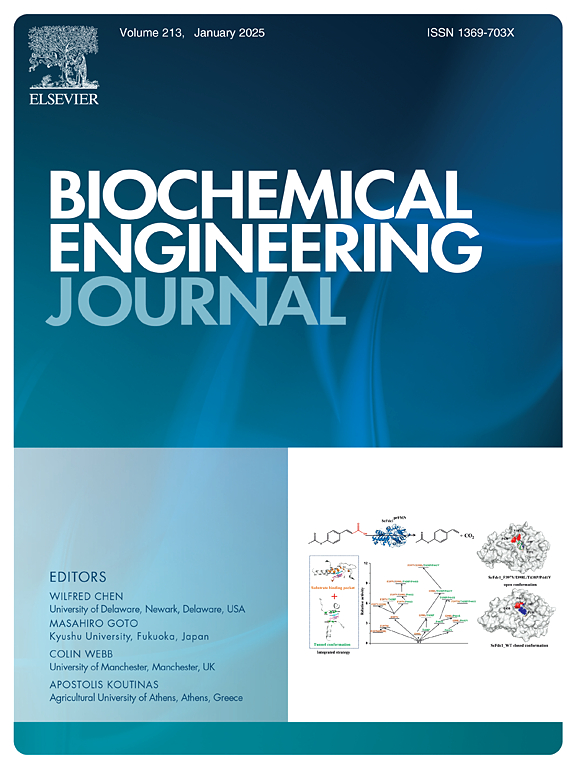Scaling iPSC production in different 3D platforms in suspension culture for their use in allogeneic regenerative therapies
IF 3.7
3区 生物学
Q2 BIOTECHNOLOGY & APPLIED MICROBIOLOGY
引用次数: 0
Abstract
Human induced pluripotent stem cells (iPSCs) exhibit significant potential for regenerative medical treatments due to their pluripotency and proliferation capacity. However, the large-scale production required for allogeneic therapies necessitates efficient and scalable culture systems. Conventional 2D culture techniques are inadequate for this, driving interest for innovative bioreactor-based expansion techniques such as microcarrier-based or aggregate cultures. In this study, we compare iPSC expansion and quality in microcarrier and aggregate cultures in spinner flasks, aiming to ascertain which 3D growth configuration yields superior cell mass while maintaining cellular quality. We demonstrated comparable expansion of iPSCs on Cytodex 1 and Cultisphere G microcarriers, as well as in aggregates by day 6 in culture, achieving a final cell density of cells/ml and cells/ml on microcarriers respectively, and cells/ml in aggregates, yielding 4- and 9-fold expansion on microcarriers and 15-fold in aggregates. The efficiency in the recovery of iPSCs as single cells was over 91.5 % for all cultures. iPSCs cultured on microcarriers and as aggregates exhibit OCT3/4, SSEA4, TRA-1–60, and SOX2 pluripotency marker expression, as well as retention of differentiation potential into three germinal layers. This work supports the utilization of microcarriers and aggregates as efficient 3D expansion platforms for suspension cultures of iPSCs.
在悬浮培养的不同3D平台中扩大iPSC的生产,用于异体再生治疗
人诱导多能干细胞(iPSCs)由于其多能性和增殖能力,在再生医学治疗中表现出巨大的潜力。然而,同种异体疗法所需的大规模生产需要高效和可扩展的培养系统。传统的二维培养技术不足以满足这一需求,这促使人们对基于生物反应器的创新扩展技术(如基于微载体或聚合培养)产生兴趣。在这项研究中,我们比较了微载体和聚合培养在旋转烧瓶中的iPSC扩增和质量,旨在确定哪种3D生长结构在保持细胞质量的同时产生更好的细胞质量。我们证明了iPSCs在Cytodex 1和culsphere G微载体上以及在培养第6天的聚集体上的扩增,微载体上的最终细胞密度分别为2.6*106个细胞/ml和5.67*106个细胞/ml,聚集体上的最终细胞密度为9.76*106个细胞/ml,微载体上的扩增率为4倍和9倍,聚集体上的扩增率为15倍。在所有培养中,iPSCs的单细胞回收率均超过91.5%。在微载体和聚集体上培养的iPSCs表现出OCT3/4、SSEA4、TRA-1-60和SOX2多能性标志物的表达,并保留了分化成三个生发层的潜力。这项工作支持利用微载体和聚集体作为iPSCs悬浮培养的有效3D扩展平台。
本文章由计算机程序翻译,如有差异,请以英文原文为准。
求助全文
约1分钟内获得全文
求助全文
来源期刊

Biochemical Engineering Journal
工程技术-工程:化工
CiteScore
7.10
自引率
5.10%
发文量
380
审稿时长
34 days
期刊介绍:
The Biochemical Engineering Journal aims to promote progress in the crucial chemical engineering aspects of the development of biological processes associated with everything from raw materials preparation to product recovery relevant to industries as diverse as medical/healthcare, industrial biotechnology, and environmental biotechnology.
The Journal welcomes full length original research papers, short communications, and review papers* in the following research fields:
Biocatalysis (enzyme or microbial) and biotransformations, including immobilized biocatalyst preparation and kinetics
Biosensors and Biodevices including biofabrication and novel fuel cell development
Bioseparations including scale-up and protein refolding/renaturation
Environmental Bioengineering including bioconversion, bioremediation, and microbial fuel cells
Bioreactor Systems including characterization, optimization and scale-up
Bioresources and Biorefinery Engineering including biomass conversion, biofuels, bioenergy, and optimization
Industrial Biotechnology including specialty chemicals, platform chemicals and neutraceuticals
Biomaterials and Tissue Engineering including bioartificial organs, cell encapsulation, and controlled release
Cell Culture Engineering (plant, animal or insect cells) including viral vectors, monoclonal antibodies, recombinant proteins, vaccines, and secondary metabolites
Cell Therapies and Stem Cells including pluripotent, mesenchymal and hematopoietic stem cells; immunotherapies; tissue-specific differentiation; and cryopreservation
Metabolic Engineering, Systems and Synthetic Biology including OMICS, bioinformatics, in silico biology, and metabolic flux analysis
Protein Engineering including enzyme engineering and directed evolution.
 求助内容:
求助内容: 应助结果提醒方式:
应助结果提醒方式:


